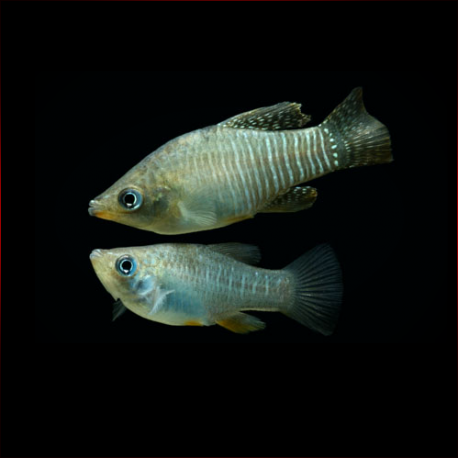More info
Datasheet
| Minimum Tank Size | 60 litres / 15.85 US gallons |
| Maximum Size | 5.0cm / 1.97inches |
| Temperature | 21°C / 69.80°F - 35°C / 95.00°F |
| Hardness | 10.03dgH / 179ppm - 30.03dgH / 536ppm |
| pH | 7.5-9.0 |
General Description
The Diamond Killifish, scientifically known as Adinia Xenica, is characterized by its stout and trapezoidal body shape, with large scales and typically fewer than 30 scales along the midlateral scale row. This species, belonging to the family Fundulidae, can reach a maximum size of 5.0cm.
Aquarium Setup
For maintaining Diamond Killifish in an aquarium, it is essential to provide many broken lines of sight and a suitable medium for egg deposition. Female and subdominant male individuals should be given respite from aggressive alpha males during the spawning season. Therefore, the tank can be equipped with acrylic wool mops, clumps of java moss, or Ceratophyllum. Filtration need not be excessive, and adding marine salt at a rate of 3-10 g/L is recommended. A tank size of at least 60 litres is advised, along with specific water conditions of 179-536ppm hardness, pH of 7.5-9.0, and a temperature range of 21-35°C.
Behaviour
The Diamond Killifish is not considered a suitable choice for a community aquarium due to its specific water chemistry requirements and rarity in the hobby. It is recommended to keep this species solitary, or in a group with a ratio of two or three females to each male being ideal.
Feeding and Diet
Being a generalist omnivore, the Diamond Killifish feeds on a variety of small organisms such as algae, diatoms, rotifers, copepods, and insect larvae. In the aquarium, they accept dried foods but should also be provided with regular meals of live or frozen food like Artemia, Daphnia, or chironomid larvae. Juveniles are noted to be more carnivorous than adults.
Reproduction & Dimorphism
Captive reproduction of the Diamond Killifish is relatively straightforward if the tank is appropriately set up. Females deposit eggs continuously between March and September, typically in the afternoon. Adult males are larger and more colorful than females, displaying longer unpaired fins and bony projections known as "contact organs" on their bodies.
Habitat and Distribution
In the wild, the Diamond Killifish inhabits shallow coastal waters like lagoons, salt marshes, and isolated pools with thick submerged vegetation. They are commonly found in brackish and hypersaline waters along the northern Gulf of Mexico, from southern Florida to Texas. The species' original collection sites include the coastal islands of Galveston and San José, as well as Indianola, a former port town in Texas.

